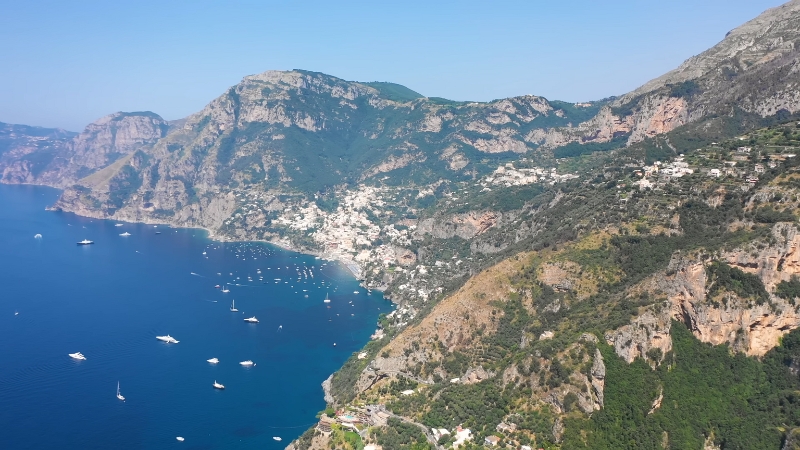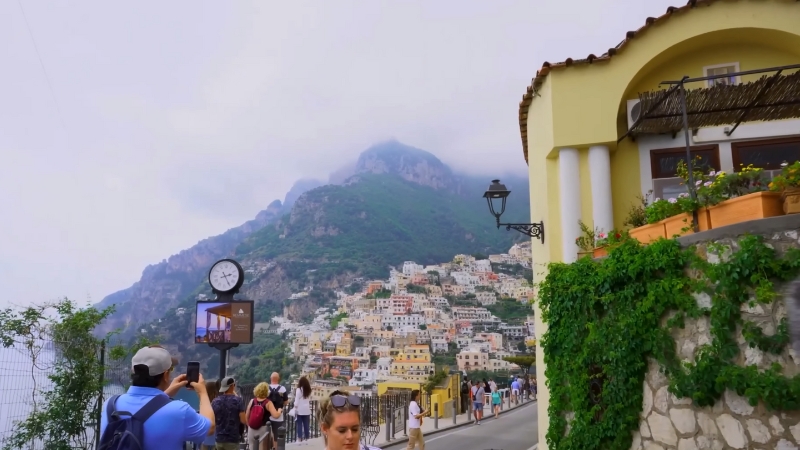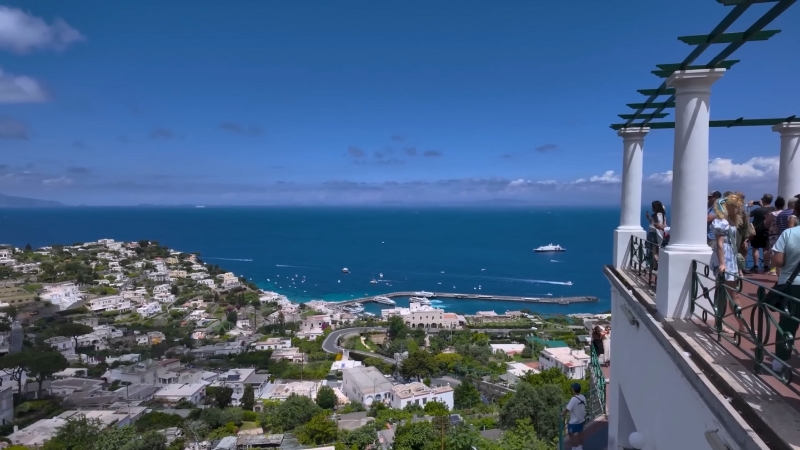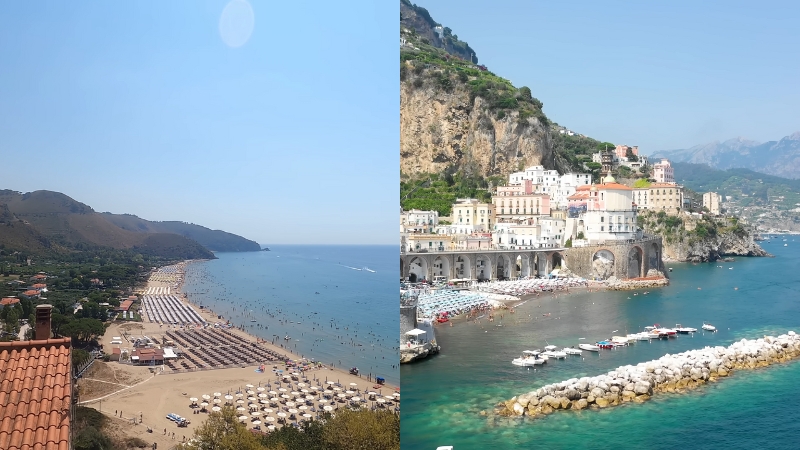Have you ever wondered what makes a seaside destination truly unforgettable? Is it the dramatic cliffs plunging into turquoise waters, or the quiet charm of a village where time slows down? Italy’s coastlines deliver both, but in very different ways.
Amalfi has long been the poster child for Mediterranean glamour. Sperlonga, on the other hand, is the quietly confident beauty that doesn’t need to shout to get your attention.
Let’s take a closer look at what each has to offer, and along the way, ask the questions that can help you decide which one might best fit your travel dreams.
Key Points
- Amalfi offers dramatic cliffs, medieval history, luxury stays, and bustling summer crowds.
- Sperlonga provides long sandy beaches, Roman ruins, easy Rome access, and lower prices.
- Both have fresh seafood, coastal charm, and ideal spring or fall travel conditions.
- Amalfi suits glamour-seekers; Sperlonga fits travelers wanting a quieter, local feel.
Locations and Accessibility

Planning a trip always starts with one key factor: getting there. The Amalfi Coast stretches along the southern edge of the Sorrentine Peninsula in Campania, about 50 kilometers south of Naples.
This UNESCO World Heritage site is a chain of cliffside towns like Positano, Amalfi, and Ravello, each seemingly glued to the rocks above the Tyrrhenian Sea.
The nearest major gateway is Naples International Airport. From there, you can hop on a SITA bus, hire a private driver, or take ferries from Naples or Sorrento.
Buses are inexpensive but slow on the SS163 coastal road, a famously narrow and winding route that can be gridlocked in summer. Ferries, usually 15-20 euros per leg, are faster and offer sea views that could double as postcards.
Sperlonga sits in Lazio, almost exactly halfway between Rome and Naples, about 120 kilometers south of Rome.
Trains from Roma Termini to Fondi-Sperlonga take roughly 90 minutes, followed by a short bus ride.
Driving from Rome takes around two hours, mostly on highways before switching to gentler coastal roads.
For visitors landing in Rome, it’s an easy day trip, meaning you can swim in the sea and still be back in the city for dinner.
Takeaway for Trip Planners
Amalfi rewards those willing to navigate more complex routes, while Sperlonga offers quick access, especially from Rome.
History and Culture
For some travelers, the beach is just half the story – history adds the texture. In its heyday, Amalfi was a maritime powerhouse, trading across the Mediterranean and rivaling Venice and Genoa.
Saint Andrew’s relics landed in Amalfi in 1206 & remain enshrined in the Duomo’s crypt 🌟 Explore this medieval marvel with Show Me Italy—history, faith & coastal beauty in one tour! 🇮🇹 Book now ➡️ https://t.co/117Ym3qP5T #Amalfi #SaintAndrew #ItalyTravel #showmeitaly pic.twitter.com/bIZ2ZXwMux
— Show Me Italy (@showmeitaly) July 23, 2025
The Duomo di Amalfi, with Byzantine mosaics and relics of Saint Andrew, is a direct link to its medieval glory. Ravello’s Villa Rufolo and Villa Cimbrone speak to Renaissance elegance and still host open-air concerts against sweeping coastal backdrops.
Lemon terraces, cultivated since the 11th century, are more than just photogenic – they’re the source of the region’s famed limoncello.
Sperlonga tells an older story. Around 14 AD, Emperor Tiberius built a seaside villa here, complete with a grotto decorated with sculptures depicting scenes from Homer’s Odyssey.

The National Archaeological Museum of Sperlonga houses these pieces today. The old town, painted white and threaded with narrow alleys, has a Greek island feel, earning a place in I Borghi più belli d’Italia, Italy’s list of most beautiful villages.
If you’re the kind of traveler who likes to step back into the Roman Empire, Sperlonga’s quiet ruins feel personal. If medieval trade routes and ornate cathedrals captivate you, Amalfi’s living history will not disappoint.
Beaches and Natural Beauty
Beaches can be a deciding factor – and here, the difference is noticeable. The Amalfi Coast is about drama, not breadth. Its beaches are typically small and pebbly, tucked between cliffs.
Positano’s Spiaggia Grande is the most famous, a wide arc lined with umbrellas and restaurants. Atrani’s pale-sand patch sits beside a postcard-perfect village.
View this post on Instagram
The Fiordo di Furore is a narrow fjord beach beneath a bridge, accessible by steep stairs. Many of the best coves require boat access. The water is crystal-clear, earning Blue Flag status in several spots, but in peak season, you’ll share the space with many others.
Sperlonga, by contrast, stretches out golden sands for over two kilometers. The main beach has shallow, calm waters perfect for swimming and snorkeling. Behind the sand, pine trees and dunes give it a softer, wilder edge.
Blue Flag certification here speaks to the clean water and environmental care. The Grotto of Tiberius adds an archaeological twist just steps from the shoreline.
You’ll find both free public sections and private lidos renting umbrellas for around 20 euros a day.
Quick Beach Comparison
| Aspect | Amalfi Coast | Sperlonga |
| Beach Type | Pebbly coves, some small sandy spots | Long golden sandy stretches |
| Accessibility | Often via stairs or boat | Easy walk or drive |
| Water Clarity | Crystal-clear, turquoise | Clear, shallow for swimming |
| Unique Features | Cliffs, fjords like Furore | Roman grotto, pine-backed dunes |
| Crowds | High in peak season | Moderate, more local |
Accommodations and Costs

Your lodging budget can shape your entire experience. Amalfi is famous for luxury stays with views that stop you mid-step.
The Anantara Convento di Amalfi Grand Hotel, a converted 13th-century monastery, starts at around 500 euros per night in summer.
Mid-range hotels in towns like Maiori or Minori may run 150-300 euros. Dining with a sea view can easily hit 30 euros per meal, and private beach access often adds another 20-50 euros. Prices peak in July and August, with 2025 rates averaging 15 percent higher than previous years.
Sperlonga delivers charm at lower prices. Boutique hotels like the Virgilio Grand Hotel start around 200 euros. Apartments and B&Bs can be found for 100 euros a night, and a seafood dinner often costs about 20 euros.
Its closeness to Rome also means you could skip overnight stays altogether and save. If you’re budgeting for a longer Italian trip, Sperlonga’s affordability might free up funds for other experiences.
Food and Dining
Italy’s seaside towns live and breathe through their kitchens. Amalfi’s menus lean heavily into its famous lemons, from tangy limoncello to pasta tossed with zest and olive oil.
Seafood is a highlight: scialatielli ai frutti di mare is a fresh, thick pasta with clams, mussels, and prawns. Anchovies from Cetara are world-renowned, particularly in the form of colatura di alici, a savory fish sauce.
In Sperlonga, Lazio’s influence blends with coastal traditions. You’ll see spaghetti alle vongole (clams) alongside fried seafood cones sold from stalls.
Its gelato scene is strong, with some places serving tartufo imported from Calabria. Proximity to Rome means dishes like cacio e pepe occasionally pop up on menus, adding variety for returning visitors.
Both places prize freshness, but Sperlonga’s smaller, family-run restaurants can feel more personal – and easier on the wallet.
Activities and Attractions
View this post on Instagram
Not every day has to be about sand and saltwater. In Amalfi, the Path of the Gods is one of Italy’s most famous hikes, spanning about 7 kilometers from Agerola to Positano with sweeping sea views from 500 meters up.
Boat tours can take you into hidden grottos or along the coastline at sunset. Ravello’s summer music festival transforms its gardens into open-air stages.
In Sperlonga, you can rent a bike and explore pine forests, walk the old town’s alleys, or visit the Tiberius villa site. Nearby Gaeta offers a medieval castle and hiking trails at Monte Orlando.
Water sports like paddleboarding and kayaking are readily available, but without the dense crowds.
Crowds and Atmosphere
Crowds shape the mood. Amalfi draws over 5 million visitors annually. In July and August, buses are full, beaches are packed, and restaurants are booked.
The energy is high, with international accents filling the air. Sperlonga welcomes about 200,000 visitors a year, many of them Italian.
It feels lived-in and local, with enough tourism to keep services running smoothly but without overwhelming the town. Even in summer, you can find space to breathe.
Best Time to Visit
For both destinations, spring (April-June) and fall (September-October) bring mild weather, fewer people, and better rates.
In summer, Amalfi’s charm comes with intense heat and crowds, while Sperlonga’s beach season peaks with families and day-trippers from Rome.
Winter in either town is quiet, with some hotels and restaurants closing, but walks along the coast are peaceful.
How to Make the Most of Your Trip

For Amalfi
- Book ferries and key accommodations early.
- Wear comfortable shoes for steep stairs.
- Use ferry or bus apps to track schedules.
- Pack light if you plan to move between towns.
For Sperlonga
- Visit the archaeological museum midweek for a quieter experience.
- Bring a light jacket in spring or fall – evenings can be breezy.
- Rent bikes to explore nearby coves.
- Check beach lido prices in advance if you prefer a setup over free sand.
Which Seaside Speaks to You?

Amalfi is the head-turner, the place you’ve likely seen in glossy travel spreads. Sperlonga is the quieter beauty, waiting patiently for you to notice her. Both offer Italy’s coastal magic, just in different doses.
Albania and Montenegro share a similar contrast, one known for its rising buzz, the other for its quieter allure.
If your itinerary allows, you could let Amalfi dazzle you for a few days, then retreat to Sperlonga’s easy pace and sandy shores.
Your perfect seaside experience is out there – and it might just be the one you weren’t looking for.

